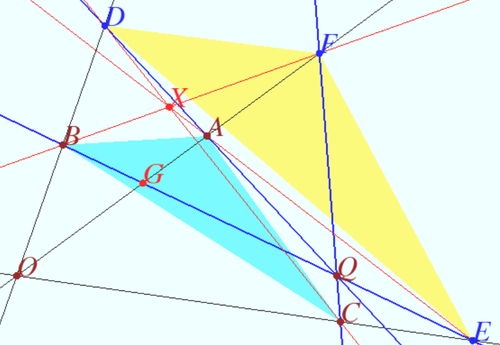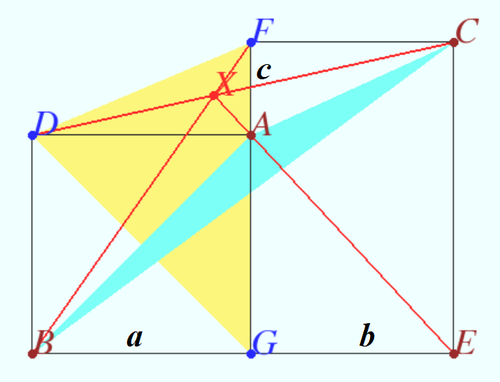Difference between revisions of "Double perspective triangles"
(→Two triangles in double perspective are in triple perspective) |
(→Two triangles in double perspective are in triple perspective) |
||
| (2 intermediate revisions by the same user not shown) | |||
| Line 3: | Line 3: | ||
==Two triangles in double perspective are in triple perspective== | ==Two triangles in double perspective are in triple perspective== | ||
[[File:Exeter B.png|500px|right]] | [[File:Exeter B.png|500px|right]] | ||
| + | [[File:Exeter C.png|500px|right]] | ||
Let <math>\triangle ABC</math> and <math>\triangle DEF</math> be in double perspective, which means that triples of lines <math>AF, BD, CE</math> and <math>AD, BE, CF</math> are concurrent. Prove that lines <math>AE, BF,</math> and <math>CD</math> are concurrent (the triangles are in triple perspective). | Let <math>\triangle ABC</math> and <math>\triangle DEF</math> be in double perspective, which means that triples of lines <math>AF, BD, CE</math> and <math>AD, BE, CF</math> are concurrent. Prove that lines <math>AE, BF,</math> and <math>CD</math> are concurrent (the triangles are in triple perspective). | ||
| Line 15: | Line 16: | ||
<i><b>Claim for square</b></i> | <i><b>Claim for square</b></i> | ||
| − | Let <math>ADBG</math> be the square, let <math>CEGF</math> be the rectangle, <math>A \in FG, G \in BE.</math> | + | |
| + | Let <math>ADBG</math> be the square, let <math>CEGF</math> be the rectangle, <math>A \in FG, G \in BE.</math> | ||
| + | |||
Prove that lines <math>BF, CD,</math> and <math>AE</math> are concurrent. | Prove that lines <math>BF, CD,</math> and <math>AE</math> are concurrent. | ||
| Line 21: | Line 24: | ||
Let <math>BG = a, GE = b, AF = c, A = (0,0).</math> Then | Let <math>BG = a, GE = b, AF = c, A = (0,0).</math> Then | ||
| − | <cmath>B=( | + | <cmath>B = (-a, -a), F = (0,c), BF: y = x (1 + \frac {c}{a})+c.</cmath> |
| − | <cmath>E=(b, | + | <cmath>E=(b, -a), AE: y = -\frac {a}{b}x.</cmath> |
| − | <cmath>D = ( | + | <cmath>D = (-a,0), C= (b,c), CD: y = c \frac {x+a}{a+b}.</cmath> |
| − | < | + | <cmath>X = CD \cap AE \cap BF = (-bk, ak),</cmath> |
| + | where <math>k= \frac {c} {a+b +{\frac {bc}{a}}}</math> as desired. | ||
'''vladimir.shelomovskii@gmail.com, vvsss''' | '''vladimir.shelomovskii@gmail.com, vvsss''' | ||
Latest revision as of 13:51, 5 December 2022
Double perspective triangles
Two triangles in double perspective are in triple perspective
Let ![]() and
and ![]() be in double perspective, which means that triples of lines
be in double perspective, which means that triples of lines ![]() and
and ![]() are concurrent. Prove that lines
are concurrent. Prove that lines ![]() and
and ![]() are concurrent (the triangles are in triple perspective).
are concurrent (the triangles are in triple perspective).
Proof
Denote ![]()
It is known that there is projective transformation that maps any quadrungle into square.
We use this transformation for ![]() .
We use the Claim for square and get the result: lines
.
We use the Claim for square and get the result: lines ![]() and
and ![]() are concurrent.
are concurrent.
Claim for square
Let ![]() be the square, let
be the square, let ![]() be the rectangle,
be the rectangle, ![]()
Prove that lines ![]() and
and ![]() are concurrent.
are concurrent.
Proof
Let ![]() Then
Then
![]()
![]()
![]()
![]() where
where ![]() as desired.
as desired.
vladimir.shelomovskii@gmail.com, vvsss











